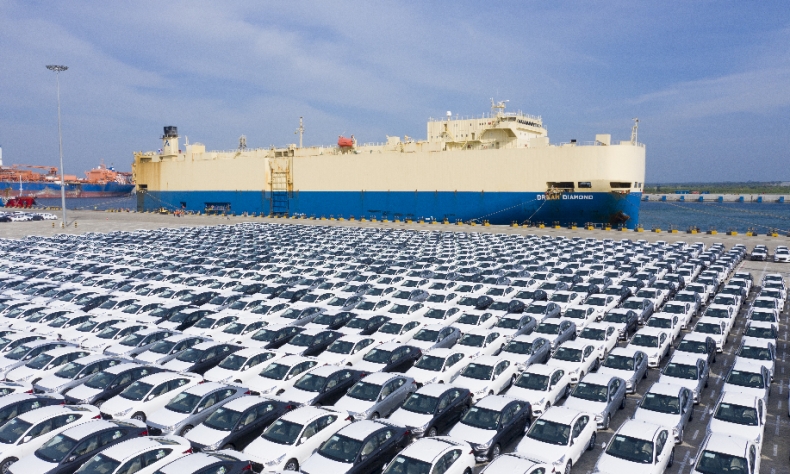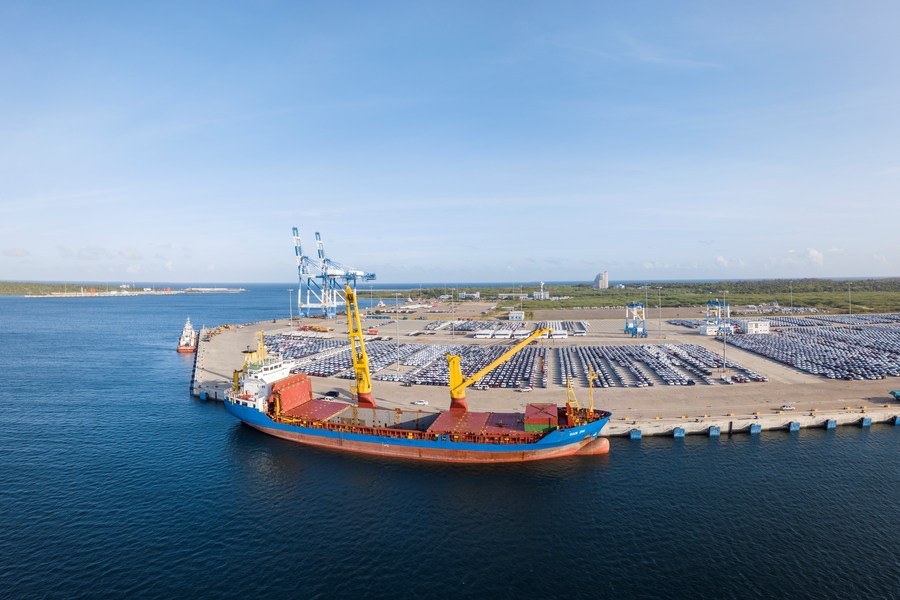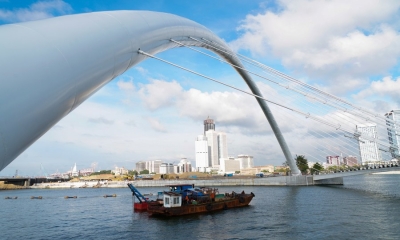With the Belt and Road Initiative, Hambantota Port Is Becoming a Regional Energy Hub

The HIP is a flagship project of cooperation between Sri Lanka and China under the BRI and all these developments are set to bring win-win results to Sri Lanka and China.
The Hambantota International Port (HIP) is a deep-water port being developed in phases in Hambantota, southern Sri Lanka. This port is located 10 nautical miles from the major international east-west shipping route — the Suez Canal and the Strait of Malacca, and is well positioned at a strategic location on the maritime gateway to India. Generally, about 300 ships pass this route per day and create good business opportunities for providing terminal services, port services, and marine services.
HIP is Sri Lanka’s most diversified deep-water, multi-purpose port, with 10 berths in Phases 1 and 2 and a quay length of up to 3,487 meters. The berths are specialized to handle containers, bulk cargo, general cargo, RO-RO cargo and liquid bulk. It operates across a number of business sectors, namely RO-RO, Container Cargo, Conventional cargo, Dry Bulk Cargo, Breakbulk Cargo, Project Cargo, Liquid Bulk Cargo (LPG, LNG), Petro Chemicals, Marine Bunker Fuel and Cruise Terminals.
Water depth alongside the quay and navigation channel is -17 meters, which makes Hambantota Port a deep-water port capable of handling super-mega vessels. Hambantota Port also has great potential for future expansion, with its hinterland covering the South Asian region, and as a maritime hub in the region.
Sri Lanka Ports Authority (SLPA) operated the Hambantota Port from its opening in 2012 to the end of 2016, but it failed to meet profitability due to inadequate governance, lack of commercial and industrial activities, and its inability to attract passing vessels to dock at the port. Likewise, the bunkering business failed to take off due to SLPA not having a strategic international partner. Hambantota Port was unable to generate sufficient revenue to meet its loan obligations to construct the port.
As a result, in July 2017, Sri Lanka decided to sign a concession agreement with China Merchants Port Holdings Company Limited (CMPort) to operate the Hambantota Port along with 1,235 acres of land as a Private Public Partnership (PPP) project on a 99-year lease. On December 9, 2017, two Sri Lankan companies established under the concession agreement, namely Hambantota International Port Group (HIPG) and Hambantota International Port Services Co. Ltd. (HIPS). The two companies officially took over the Hambantota Port, with a payment of $1.12 billion, for the acquisition of 85 percent stake of HIPG and 58 percent stake of HIPS. The remaining percent of the stake of HIPG and HIPS are owned by the SLPA. At the time of entering into the lease agreement, Hambantota Port’s value was assessed at $1.4 billion. The PPP is not a debt-equity swap but a fresh investment by CMPort. After undertaking the Hambantota port, CMPort further invested in restructuring and transformed it to be a commercially viable national asset in collaboration with the SLPA.

CMPort is an important subsidiary of China Merchants Group, and it is a world-leading port developer, investor, and operator. The company has established an extensive port network that includes major hub ports along the coast of China. CMPort controls or has invested in terminals located in Hong Kong, Taiwan, Shenzhen, Ningbo, Shanghai, Qingdao, Tianjin, Dalian, Zhangzhou, Zhanjiang, Shantou, and other container hub ports, and has successfully expanded its network to South Asia, Africa, America, Oceania, Europe, and the Mediterranean. A leading global port operator, the company has continuously expanded its port business overseas since 2008 and has accelerated its pace of internationalization in recent years. As of December 31, 2022, the company has invested or taken a minority stake in 42 ports in 25 countries or regions. In 2022, the company’s container throughput reached 136.53 million TEUs and its bulk cargo throughput reached 547 million tons.
CMPort’s parent company, China Merchants Group Limited, is a Hong Kong-based conglomerate established in 1872 whose three core businesses include Transportation, Finance and Property. China Merchants Group Limited has rich experience and resources in implementing the “Port + Park + City” Model (e.g. Shekou, Zhangzhou). The significant landmass of the project in Hambantota Port (approximately 11.5km2 port area) gives leeway for the Company to implement and capitalize on the said model to add substantial value to the port operations and development.
Since CMPort started to operate Hambantota Port in 2017, it has witnessed remarkable growth. On December 30, 2023, the HIP proved itself as the fastest-growing RO-RO transshipment port in the region. With 700,000 transshipment vehicles handled, the port marked a significant 26 percent increase from 2022 figures. The HIP made an $8 million investment last year to build another 68,000 square meters of parking space to add a further 5,000 slots to accommodate transshipment vehicles in addition to the current capacity to accommodate approximately 28,000 units.
As part of the long-term development strategy of HIP, the port also has successively introduced oil and gas business in April 2019. And awarded a tender to Sinopec Fuel Oil Sales Co. Limited for oil trading works and the operation and maintenance of their oil tank terminal along with associated facilities. Bunkering is an important part of the energy services portfolio offered by HIP.
In March 2020, HIP began bunkering for ships that call at the port with the first shipment of Very Low Sulphur Fuel Oil (VLSFO) 380 CST discharged in a newly refurbished Lloyds-certified oil storage facility. In February 2021, HIP achieved another milestone in its multi-services portfolio when it launched the wholesale supply of Marine Bunker fuels, together with its strategic partner Sinopec Fuel Oil Lanka Limited (SFOL). This initiative provided a competitive price for Sri Lankan licensed Bunker Suppliers who are involved in supplying bunkers for vessels calling at any Port in Sri Lanka or plying the busy East-West Shipping route.
The partnership with Sinopec, which is one of the largest providers of bunkers worldwide, underlines BIA’s goal of becoming a bunkering hub for the entire region. The Beijing-based Sinopec is a super-large petroleum and petrochemical group that has a registered capital of 326.5 billion yuan, with its business scope all over the world — mainly including oil and gas exploration and production, oil refining, oil sales, and petrochemical industry.
In May 2021, HIP partnered with Intertek Lanka (Pvt) Ltd to establish a state-of-the-art petroleum testing laboratory for testing marine products and bunkering and bunker-related inspections. Petroleum testing is an important activity in port related services.
The HIP has benchmarked a 500,000-ton volume in their bunkering business during the first eight months of 2023 which is over 80 percent of the marine bunker market in Sri Lanka. The throughput is five times in volume compared to 2022.
In 2023, over 300 oil and gas cargo vessels visited the HIP, recording a 132 percent increase in vessel calls compared to 2022. The overall oil & gas throughput handled by the port in 2023 was 918,000 MT with 700,000 MT of bunker and 218,000 MT LPG cargoes.
All these facts show that the HIP is moving towards the target of an energy hub in the region. The partnership with CMPort and Sinopec is definitely a boost for the Sri Lankan oil and gas industry. The HIP is a flagship project of cooperation between Sri Lanka and China under the Belt and Road Initiative (BRI) and all these developments are set to bring win-win results to Sri Lanka and China. Through the high-quality BRI vision, it is expected to bring brighter prospects to Sri Lanka.
The article reflects the author’s opinions, and not necessarily the views of China Focus.
 Facebook
Facebook
 Twitter
Twitter
 Linkedin
Linkedin
 Google +
Google +




